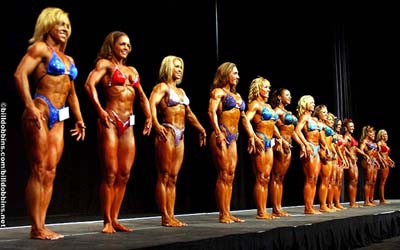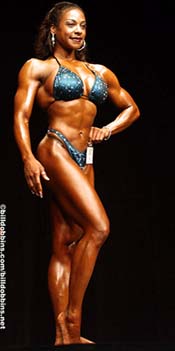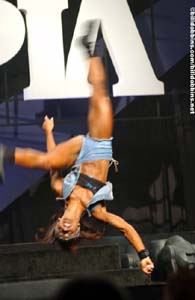THE FITNESS OLYMPIA
Mandalay Bay, Las Vegas –
November 18TH
back
By Bill Dobbins
 |
Fitness lineup or lightweight
bodybuilders? Hard to tell. |
In the case of pro fitness, the “usual suspects” include such competitors as Susan Curry, Kelly Ryan, Adelina Friedmansky and Jenny Worth. How did they achieve this status? By winning a number of shows – or placing very high – thereby become the “model” in the judges’ minds for what a pro fitness champion is supposed to look like. Success has bred success – although it certainly hasn’t hurt that in a type of competition that places disproportionate emphasis on gymnastics that they are all trained gymnasts.
All of these women not only are gymnasts – they also look like gymnasts. That’s why most fitness women who try to switch to “figure” are disappointed. As fitness competitors are discouraged from “looking like bodybuilders” so the judges in figure tend to prefer taller proportioned, more slender women in figure. Watch contests and you’ll see the difference in champion fitness and figure physiques.
 |
| Stacy Simons - potential bodybuilding champion? |
Nonetheless, it was obvious at the Fitness Olympia that the IFBB has failed to take into consideration the physiological consequences of having a lot of genetically gifted athletes train with weights over a period of years – they tend to get a lot more muscular. And so the lineup at the Fitness Olympia 2002 looked in large part like the lightweight class that didn’t exist in the Ms. Olympia. In other words, they looked a great deal like bodybuilders!
At one point I looked at the side of the stage and standing in line
were Stacy Simons, Kelly Ryan, Tracey Greenwood, and Aleksandra Kobielak.
The first three already look like bodybuilders (Stacy’s deltoids are
better than many of the women in the Ms. Olympia) and Aleksandra has the
frame to become a bodybuilder. There was also Jen Hendershott and
Laurie Vaniman, again women who look like lightweight bodybuilders.
Whether the federation likes it or not, just as the female bodybuilders
tend to get bigger and more muscular over time – which is the whole
point of doing serious weight training – so do the fitness women.

Another good example of this evolution is Fitness Olympia champion Susan Curry. In the past, Susie has appeared extremely slender, with almost stick-figure legs. But on stage in Las Vegas it was obvious she had filled out and shaped up - the result of building more muscle size and fullness.
Check out the backstage photos and see how difficult it is to tell which women are in which category. There is anamazing similarity. This is even more pronounced since the bodybuilding women looked so attractive in this contest. The FBBs are getting more aesthetic, the fitness competitors more muscular. This is why I always advise fitnesscompetitors not to say anything negative about female bodybuilders in interviews. When fitness is shown on television the events are often designated as “bodybuilding” in the tube guides and many viewers can’t tell the difference. So bad mouthing bodybuilding can easily result in creating negative reactions to people who think they are watching bodybuilding but are really seeing a fitness contest.
As far as the 2002 Fitness Olympia is concerned, there were no real surprises. The “usual suspects” were called out for comparison by the judges and the routines performed by the super-gymnasts such as Susan, Kelly, Jeniffer Worth, Adelina and Jen Hendshott were excellent as usual. Although Susan Curray got all first place votes in the final round, the judges were mixed in their reaction to the competitors throughout the rest of the contest. Winning this one was no slam dunk. There was nobody considered the unanimous favorite of all the judges – which is reasuring, since there really aren’t any specific “standards” you can use to judge fitness. Still, standards or not, you have to be concerned about a judging policy that would result in a competitor like Aleksandra Kobielak being placed last? What were the judges thinking?
What will happen in the future is still up in the air. Will the IFBB attempt to crack down on muscle in pro fitness as they have in the past? (Ironically, at one point NPC fitness champions were considered too muscular for the pros!) What effect will introducing figure into pro competition have on the course of women’s physique in general? And what about all the tumbling still evident in fitness events? Will some legal consultant advise the IFBB how vulnerable they are having fitness competitors – some with little long-term gymnastics training – doing tumbling runs on a bare wood – sometimes slippery – floor?
All this remains to be seen. Much depends on whether IFBB officials actually sit down, think about and discuss these issues – something they have done little of in the past. In the meantime, expect to see fitness women becoming more muscular over time. And if women’s bodybuilding continues to improve its image as it did decisively with the success of the Ms. Olympia 2002, you may well see at least some fitness women who no longer want to go through the rigors and dangers of tumbling routines moving to bodybuilding instead of figure.